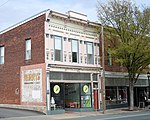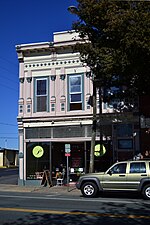Hotel Gleason/Albemarle Hotel, Imperial Cafe
Buildings and structures in Charlottesville, VirginiaCharlottesville, Virginia Registered Historic Place stubsHotel buildings completed in 1896Hotel buildings on the National Register of Historic Places in VirginiaNational Register of Historic Places in Charlottesville, Virginia ... and 1 more
Victorian architecture in Virginia

Hotel Gleason/Albemarle Hotel, Imperial Cafe is a historic hotel and commercial building located at Charlottesville, Virginia. It was built in 1896, and has a three-bay, three-story pressed-brick facade raised above the ground-floor recessed loggia in the Late Victorian style. The loggia is supported on four Corinthian order columns. The hotel closed in 1976.It was listed on the National Register of Historic Places in 1983.
Excerpt from the Wikipedia article Hotel Gleason/Albemarle Hotel, Imperial Cafe (License: CC BY-SA 3.0, Authors, Images).Hotel Gleason/Albemarle Hotel, Imperial Cafe
West Main Street, Charlottesville
Geographical coordinates (GPS) Address Nearby Places Show on map
Geographical coordinates (GPS)
| Latitude | Longitude |
|---|---|
| N 38.031111111111 ° | E -78.489166666667 ° |
Address
West Main Street 620,622,624
22903 Charlottesville
Virginia, United States
Open on Google Maps










